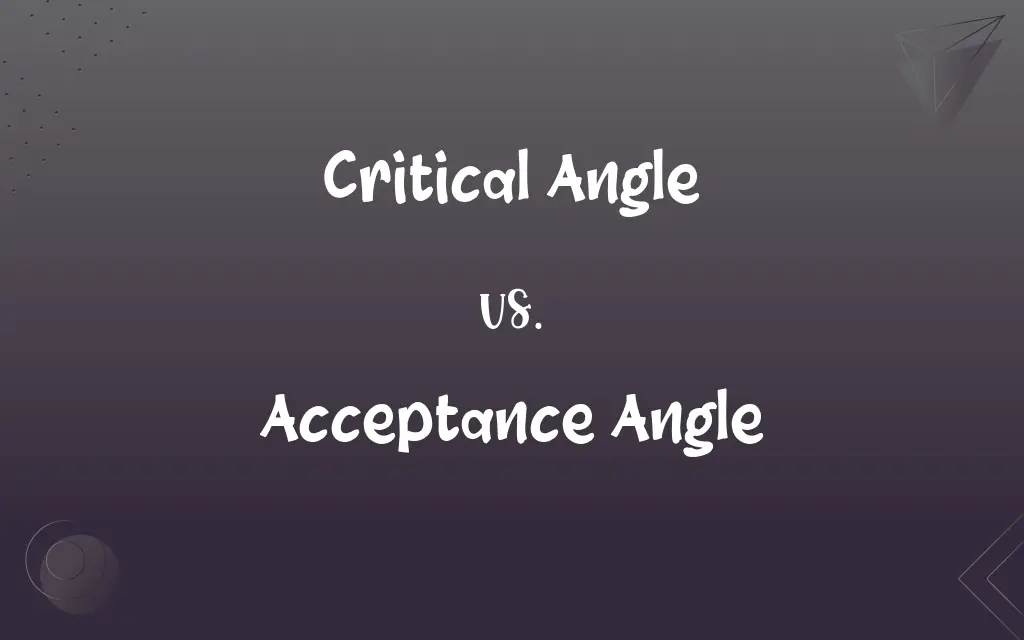Critical Angle vs. Acceptance Angle: What's the Difference?
Edited by Aimie Carlson || By Janet White || Published on March 1, 2024
Critical angle is the minimum angle of incidence for total internal reflection, while acceptance angle is the maximum angle at which light can enter a fiber to propagate.

Key Differences
The critical angle is a fundamental concept in optics, particularly in the phenomenon of total internal reflection. It is the minimum angle of incidence at which light rays are completely reflected back into a medium, rather than refracting out of it. In contrast, the acceptance angle is a term used primarily in fiber optics. It defines the maximum angle at which an incoming light ray can strike the fiber's interface and still be propagated through the fiber.
The critical angle pertains to the boundary condition for total internal reflection, the acceptance angle is more about the practical application in fiber optics, dictating how light is captured and guided in a fiber. Both angles are deeply rooted in the principles of optics, yet they serve different purposes: the critical angle is about preventing light from leaving a medium, and the acceptance angle is about ensuring light enters and stays within a medium.
Understanding the critical angle is essential for applications involving light confinement, such as in optical fibers, lasers, and certain types of sensors. It is a key parameter in designing devices that rely on total internal reflection to function. On the other hand, the acceptance angle is vital for the design and installation of optical fiber systems, including telecommunications and medical imaging devices, as it affects the fiber's ability to collect and transmit light efficiently.
Both the critical angle and the acceptance angle highlight the intricate interplay of light with materials, each from a different perspective. The critical angle underscores the conditions for total internal reflection, a cornerstone of many optical devices and phenomena. Conversely, the acceptance angle focuses on the practical aspects of light transmission in fiber optics, emphasizing the importance of alignment and geometric considerations in the efficient use of light.
Comparison Chart
Definition
Minimum incidence angle for total reflection
Maximum entry angle for light in optical fiber
ADVERTISEMENT
Context
Total internal reflection
Fiber optics
Dependency
Refractive indices of two media
Refractive indices of core, cladding, and air
Application
Optics, lasers, sensors
Telecommunications, medical imaging
Importance
Prevents light from leaving medium
Ensures light enters and propagates in fiber
Critical Angle and Acceptance Angle Definitions
Critical Angle
"Threshold angle for total internal reflection."
The critical angle in a diamond is what gives it a sparkling appearance.
ADVERTISEMENT
Acceptance Angle
"Upper angle boundary for light entry into an optical medium."
Enhancing the acceptance angle can improve the performance of endoscopes.
Critical Angle
"The angle beyond which light reflects entirely inside a medium."
In a prism, the critical angle causes light to reflect internally, creating vivid colors.
Acceptance Angle
"Threshold for incoming light to be guided in a fiber."
The acceptance angle is key to maximizing data transmission in optical networks.
Critical Angle
"Minimum angle for light to reflect, not refract, at an interface."
Fiber optics rely on the critical angle to keep light signals intact.
Acceptance Angle
"Maximum angle for light to enter and propagate through a fiber."
The acceptance angle determines the efficiency of a fiber optic cable.
Critical Angle
"Angle at which light transitions from refraction to reflection."
The critical angle is crucial for the operation of optical fibers.
Acceptance Angle
"Angle defining the light capture efficiency of a fiber."
The acceptance angle affects the brightness and quality of images in fiber optic cameras.
Critical Angle
"Specific angle of incidence for light at a medium boundary."
The critical angle between water and air is about 48.6 degrees.
Acceptance Angle
"Angular limit for light capture in optical fibers."
A wide acceptance angle allows for better light collection in fiber optics.
FAQs
Can the critical angle be observed in all materials?
Only when light moves from a denser to a rarer medium.
How does the critical angle affect fiber optic communication?
It ensures light stays within the fiber, allowing for efficient signal transmission.
How is the critical angle determined?
By the refractive indices of the two media at the boundary where light is incident.
How does the acceptance angle impact fiber optic performance?
It determines the fiber's efficiency in capturing and transmitting light.
What is the acceptance angle in fiber optics?
The maximum angle at which light can enter a fiber and be guided along it.
What happens if light hits a surface below the critical angle?
It partially refracts out of the medium and partially reflects back.
What is the significance of the critical angle in optics?
It's crucial for devices that rely on total internal reflection, like optical fibers and prisms.
Why is the acceptance angle important for telecommunications?
It affects the bandwidth and data capacity of fiber optic cables.
What is the critical angle?
It's the minimum angle at which light reflects entirely within a medium, causing total internal reflection.
Can we see the effects of the critical angle in daily life?
Yes, in phenomena like the sparkle of diamonds or the colors in a soap bubble.
Can the acceptance angle be modified?
Yes, by altering the refractive indices of the fiber core and cladding.
How do the critical and acceptance angles relate to each other?
Both involve the interaction of light with materials but in different contexts: reflection versus transmission.
Can the critical angle be used for energy conservation?
Yes, in optical devices that trap light, like solar concentrators.
How does the acceptance angle relate to light loss in fibers?
A smaller acceptance angle can lead to greater light loss and reduced efficiency.
Is the critical angle always the same for a given material?
It varies with the medium it's transitioning into, not just the material itself.
Does the acceptance angle affect all types of fiber optics?
Yes, but its impact varies with the fiber's design and application.
What factors influence the acceptance angle of a fiber?
The core and cladding's refractive indices and the surrounding medium.
What role does the acceptance angle play in medical imaging?
It helps in capturing clear, detailed images in devices like endoscopes.
How is the critical angle relevant to underwater communications?
It's essential for the design of underwater fiber optic cables.
What advancements are being made in manipulating the critical and acceptance angles?
Research in materials science and photonics is leading to better control over these angles for improved optical devices.
About Author
Written by
Janet WhiteJanet White has been an esteemed writer and blogger for Difference Wiki. Holding a Master's degree in Science and Medical Journalism from the prestigious Boston University, she has consistently demonstrated her expertise and passion for her field. When she's not immersed in her work, Janet relishes her time exercising, delving into a good book, and cherishing moments with friends and family.
Edited by
Aimie CarlsonAimie Carlson, holding a master's degree in English literature, is a fervent English language enthusiast. She lends her writing talents to Difference Wiki, a prominent website that specializes in comparisons, offering readers insightful analyses that both captivate and inform.































































